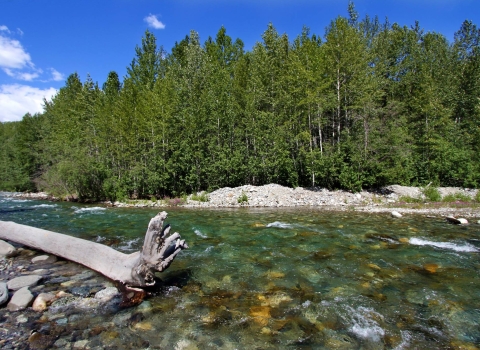Arcata, Calif. – Labor Day is all about celebrating the efforts and accomplishments of workers across the country. For many, the day off work provides a needed opportunity to relax, spend time with friends and family, or get outdoors. If you choose to celebrate on one of California’s North Coast beaches, make sure you know about the hard work that threatened western snowy plovers are doing!
From March 1st to September 15th, western snowy plovers are hard at work ensuring the continued existence of their species. They’ve had to find good breeding habitat, meet their mates, build nests (called “scrapes”), lay and incubate eggs, and care for chicks.
These little workers need your help to finish out their breeding season strong. Plovers, chicks and nests are all very small and difficult to see. This means that if you’re walking in their breeding habitat (dry sandy areas above the wrack line), you could easily disturb the birds or even step on a nest. This can be avoided by walking below the wrack line in the hard-packed wet sand areas.
Here are some other tips to help plovers successfully and safely complete their tasks:
Dogs - Know beach-specific dog rules before you go. If dogs are permitted, follow the leash rules. Do not allow your dog(s) to chase birds.
Leave space for wildlife and enjoy the birds from afar - Leave birds alone; don’t approach or chase them.
Avoid prolonged picnicking or sunbathing in plover nesting habitat (dry sand areas above the wrack line).
Walk on the wet hard-packed sand below the wrack line to avoid nesting habitat.
Respect all posted signs and/or roped-off areas for the protection of wildlife.
Camping - Camp or build fires only in designated areas.
Trash - Pack out trash, don’t leave or bury it. Garbage attracts predators such as ravens, crows, ravens, gulls, and skunks. Please dispose of all trash properly and do not inadvertently or intentionally feed wildlife.
Vehicles - If you’re on a beach that allows vehicles, drive ‘low and slow’, staying on the hard-packed sand below the high tide line where plovers forage.
Avoid driving over old vehicle or foot tracks as plovers like to rest or “loaf” in these and are extremely hard to see.
Kites - Avoid flying kites or other hovering objects near plover nesting habitat.
To balance recreational opportunities and wildlife protection along the North Coast, beach activities may be restricted to certain areas during the breeding season, March 1- September 15. You can do your part in protecting adults, chicks, and eggs by knowing and adhering to location-specific rules and regulations. For more information on the “snowy plover and you,” beach rules and regulations, beach access, and a user-friendly dog guide/map, explore the following links:
The U.S. Fish and Wildlife Service works with others to conserve, protect, and enhance fish, wildlife, plants, and their habitats for the continuing benefit of the American people. For more information about our work and the people who make it happen, visit the Arcata Fish and Wildlife Office Webpage or connect with us via Facebook, YouTube, and Flickr.
The Bureau of Land Management's mission is to sustain the health, diversity, and productivity of public lands for the use and enjoyment of present and future generations.
Friends of the Dunes is dedicated to conserving the natural diversity of coastal environments through community supported education and stewardship programs.
The California Department of Parks and Recreation’s mission is to provide for the health, inspiration and education of the people of California by helping to preserve the state's extraordinary biological diversity, protecting its most valued natural and cultural resources, and creating opportunities for high-quality outdoor recreation.




